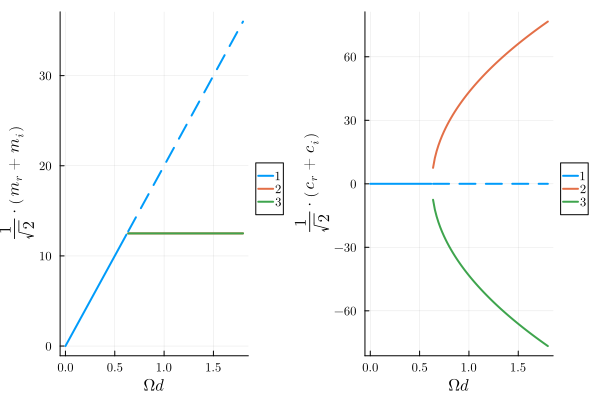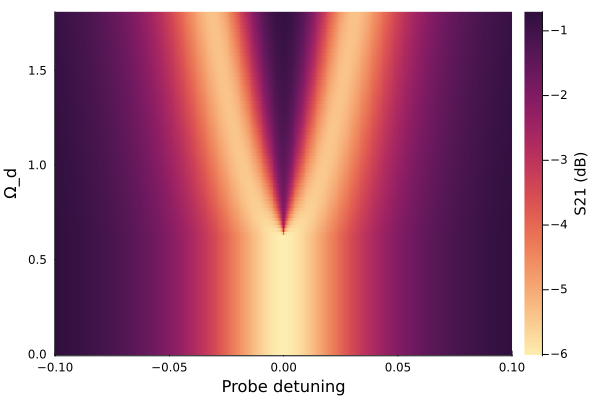Linear response and transmission/reflection coeffictients for magnon three-wave mixing
using HarmonicSteadyState, QuantumCumulants, PlotsConsider a model of nonlinear magnon-magnon coupling, as described in this paper. The model describes a three-wave mixing interaction between a strongly driven
hm = FockSpace(:magnon)
hc = FockSpace(:polariton)
h = hm ⊗ hc # Hilbertspace
@qnumbers m::Destroy(h, 1) c::Destroy(h, 2) # Operators
@rnumbers Δ Vk Ωd γm γk # Parameters
param = [Δ, Vk, Ωd, γm, γk]
H_RWA_sym = (
Δ * m' * m + Δ / 2 * c' * c + Vk * m * c' * c' + Vk * m' * c * c + (Ωd * m + Ωd * m')
)
ops = [m, m', c, c'] # Operators for meanfield evolution
eqs_RWA = meanfield(ops, H_RWA_sym, [m, c]; rates=[γm, γk], order=1)
eqs_completed_RWA = complete(eqs_RWA) # Meanfield equations using QuantumCumulants.jl\begin{align} \frac{d}{dt} \langle m\rangle &= -1 i \langle c\rangle ^{2} Vk -1 i \Delta \langle m\rangle -1 i {\Omega}d -0.5 {\gamma}m \langle m\rangle \ \frac{d}{dt} \langle m^\dagger\rangle &= 1 i \Delta \langle m^\dagger\rangle -0.5 {\gamma}m \langle m^\dagger\rangle + 1 i {\Omega}d + 1 i Vk \langle c^\dagger\rangle ^{2} \ \frac{d}{dt} \langle c\rangle &= -0.5 \langle c\rangle {\gamma}k + \frac{-1}{2} i \langle c\rangle \Delta -2 i Vk \langle m\rangle \langle c^\dagger\rangle \ \frac{d}{dt} \langle c^\dagger\rangle &= -0.5 {\gamma}k \langle c^\dagger\rangle + \frac{1}{2} i \Delta \langle c^\dagger\rangle + 2 i \langle c\rangle \langle m^\dagger\rangle Vk \end
We can use this meanfield equations to construct a HarmonicEquation object in HarmonicSteadyState.jl. In the construction, additional information is computed, such as the Jacobian of the equations, which is used to determine the stability if the the steady states.
harmonic_eq = HarmonicEquation(eqs_completed_RWA, param)A set of 4 harmonic equations
Variables: mᵣ(t), mᵢ(t), cᵣ(t), cᵢ(t)
Parameters: Δ, Vk, Ωd, γm, γk
Harmonic ansatz:
0 = mᵣ(t) + mᵢ(t) + cᵣ(t) + cᵢ(t)
Harmonic equations:
1.4142135623730951(-0.35355339059327373mᵣ(t)*γm - 0.7071067811865475mᵢ(t)*Δ - 0.9999999999999998Vk*cᵣ(t)*cᵢ(t)) ~ Differential(t)(mᵣ(t))
-1.4142135623730951(-Ωd - 0.7071067811865475mᵣ(t)*Δ + 0.35355339059327373mᵢ(t)*γm - 0.4999999999999999Vk*(cᵣ(t)^2) + 0.4999999999999999Vk*(cᵢ(t)^2)) ~ Differential(t)(mᵢ(t))
1.4142135623730951(-0.35355339059327373cᵣ(t)*γk - 0.35355339059327373cᵢ(t)*Δ - 0.9999999999999998Vk*cᵣ(t)*mᵢ(t) + 0.9999999999999998Vk*mᵣ(t)*cᵢ(t)) ~ Differential(t)(cᵣ(t))
-1.4142135623730951(-0.35355339059327373cᵣ(t)*Δ + 0.35355339059327373cᵢ(t)*γk - 0.9999999999999998Vk*cᵣ(t)*mᵣ(t) - 0.9999999999999998Vk*cᵢ(t)*mᵢ(t)) ~ Differential(t)(cᵢ(t))Let's sweep the power of the drive
drive_range = range(0, 1.8, 100)
fixed = (Δ => 0, Vk => 0.0002, γm => 0.1, γk => 0.01)
varied = (Ωd => drive_range)
result = get_steady_states(harmonic_eq, TotalDegree(), varied, fixed)
plot(plot(result; y="1/sqrt(2)*(mᵣ+ mᵢ)"), plot(result; y="1/sqrt(2)*(cᵣ + cᵢ)"))
# Linear response and S21
To find the response of the driven system to a second, weak probe, we use the method described here. Here, we calculate the response in the same rotating frame as the Hamiltonian. The linear response is related to the scattering parameter
The result below shows the characteristic splitting of the magnon resonance above the power threshold, which matches the experiment.
Ω_range = range(-0.1, 0.1, 500)
χ3 = get_susceptibility(result, 1, Ω_range, 3);
χ1 = get_susceptibility(result, 1, Ω_range, 1);
κ_ext = 0.05
S21_3 = 1 .- χ3 * κ_ext / 2
S21_log_3 = 20 .* log10.(abs.(S21_3)) # expressed in dB
S21_1 = 1 .- χ1 * κ_ext / 2
S21_log_1 = 20 .* log10.(abs.(S21_1)) # expressed in dB500×35 Matrix{Float64}:
-0.705811 -0.705811 -0.705811 … -0.705811 -0.705811 -0.705811
-0.71075 -0.71075 -0.71075 -0.71075 -0.71075 -0.71075
-0.715739 -0.715739 -0.715739 -0.715739 -0.715739 -0.715739
-0.720778 -0.720778 -0.720778 -0.720778 -0.720778 -0.720778
-0.725868 -0.725868 -0.725868 -0.725868 -0.725868 -0.725868
-0.731009 -0.731009 -0.731009 … -0.731009 -0.731009 -0.731009
-0.736202 -0.736202 -0.736202 -0.736202 -0.736202 -0.736202
-0.741448 -0.741448 -0.741448 -0.741448 -0.741448 -0.741448
-0.746748 -0.746748 -0.746748 -0.746748 -0.746748 -0.746748
-0.752102 -0.752102 -0.752102 -0.752102 -0.752102 -0.752102
⋮ ⋱
-0.746748 -0.746748 -0.746748 -0.746748 -0.746748 -0.746748
-0.741448 -0.741448 -0.741448 -0.741448 -0.741448 -0.741448
-0.736202 -0.736202 -0.736202 -0.736202 -0.736202 -0.736202
-0.731009 -0.731009 -0.731009 -0.731009 -0.731009 -0.731009
-0.725868 -0.725868 -0.725868 … -0.725868 -0.725868 -0.725868
-0.720778 -0.720778 -0.720778 -0.720778 -0.720778 -0.720778
-0.715739 -0.715739 -0.715739 -0.715739 -0.715739 -0.715739
-0.71075 -0.71075 -0.71075 -0.71075 -0.71075 -0.71075
-0.705811 -0.705811 -0.705811 -0.705811 -0.705811 -0.705811Compare the two branches
stable = get_class(result, 3, "physical")
heatmap(
Ω_range, drive_range, vcat(S21_log_1', S21_log_3'); c=:matter, cbar_title="S21 (dB)"
)
ylabel!("Ω_d")
xlabel!("Probe detuning")
This page was generated using Literate.jl.